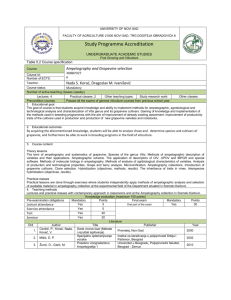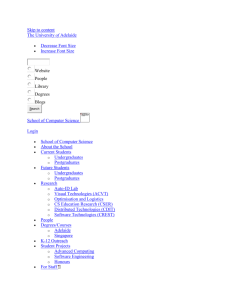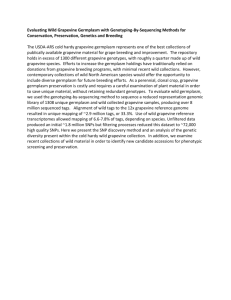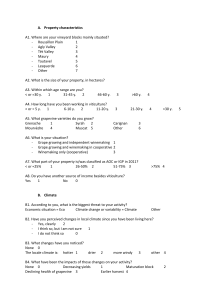GWT 1213 - Wine Australia R&D
advertisement
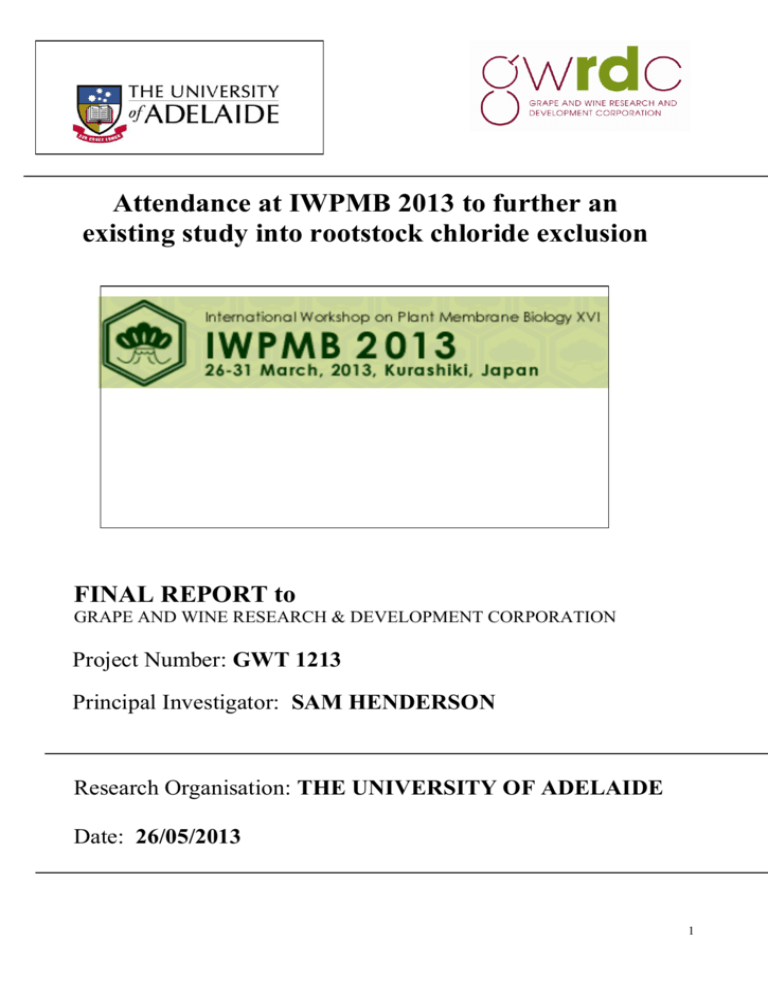
Y UR LOGO HERE O Attendance at IWPMB 2013 to further an existing study into rootstock chloride exclusion FINAL REPORT to GRAPE AND WINE RESEARCH & DEVELOPMENT CORPORATION Project Number: GWT 1213 Principal Investigator: SAM HENDERSON Research Organisation: THE UNIVERSITY OF ADELAIDE Date: 26/05/2013 1 Contents Abstract .............................................................................................................................. 3 Executive summary ............................................................................................................ 4 Background ........................................................................................................................ 5 IWPMB 2013 ...................................................................................................................... 5 Transfer of knowledge ....................................................................................................... 8 Summary ............................................................................................................................ 9 References.......................................................................................................................... 9 2 Abstract I am a GWRDC supported PhD candidate at the University of Adelaide studying chloride exclusion in grapevine rootstocks. This report summarises the outcomes of attending the XVI International Workshop on Plant Membrane Biology held in Japan from 26 th to 31st March 2013. This travel was jointly funded by the GRWDC and the University of Adelaide. The purpose of the travel was to gain exposure to outstanding research in the field of plant membranes and apply knowledge gained to enhance existing research into salt tolerance of grapevine. This report details the activities and key outcomes arising from this travel, in particular it summarises the presentations considered conference highlights to the author. 3 Executive summary Sam Henderson is a PhD candidate at The University of Adelaide studying chloride exclusion in grapevine rootstocks and the genes responsible for this process. The GWRDC supported travel to Japan to attend the 16th International Workshop on Plant Membrane Biology – a leading conference in the field that promotes discussion and the exchange of ideas among researchers. The conference consisted of 13 sessions ranging from structural physiology, abiotic stress tolerance, signalling, and crop improvement. The opportunity to attend IWPMB resulted in meeting with international researchers, with whom potential collaboration may occur in the future. It also provided new insights into our work which will help with future experimental goals. Attendance at IWPMB 1013 was highly beneficial and will aid future experiments as well as thesis and manuscript writing in the near future. The GWRDC is gratefully acknowledged for helping provide this opportunity. 4 Background The purpose of this project was to attend the sixteenth International Workshop on Plant Membrane Biology (IWPMB) which was held in Kurashiki, Japan in March 2013. The first IWPMB was held in 1968 and has since been held every three years. It is considered the premier international conference for science related to plant membranes, and is highly relevant to our research into the uptake and transport of chloride (Cl-) in grapevine which must cross cell membranes to accumulate and cause toxicity. This was the first time that IWPMB has been held in an Asian country, and was my second IWPMB after having attended at Adelaide in 2010. Hence this was a good opportunity to find out about breakthroughs that have occurred in the field in recent years. The main aims of the project were to: 1) Present my research into Cl- exclusion in grapevine to an international audience and receive feedback and advice about the future direction of the research. 2) Learn about cutting edge techniques in the field of plant membrane biology that could be applied to my research. IWPMB 2013 IWPMB 2013 included over 260 abstracts from 23 countries, and was attended by over 200 scientists (Figure 1). This demonstrates the large scale and importance of a meeting which makes up only a small portion of the plant science community. The meeting was held over 6 days without concurrent sessions, which meant it was possible to attend all presentations. Throughout the meeting, a particular theme emerged that a vast number of plant membrane transporters and channels are regulated by phosphorylation. This was elucidated with respect to nitrate transporters (Yi Fang Tsay, Academia Sinica, Taiwan), aquaporins (Christophe Maurel, CNRS/IRNA Montpellier) guard cell anion channels (Rainer Hedrich, University of Wurzburg; Julian Schroeder, UCSD; Sebastien Thomine, CNRS Paris) and many other proteins. The discovery of new phosphorylation targets is advancing rapidly in plant science. For us it is important to bear this in mind when analysing the transcriptional profiles of grapevine Cltransporters, as much of the regulation of these genes may be occurring at the posttranscriptional level. 5 Figure 1: Attendees at XVI IWPMB 2013 in Kurashiki, Japan. An interesting observation described by multiple authors was the polar localisation of membrane proteins within single cells. One oral presentation by Junpei Takano (Hokkaido University) showed that a boron channel and a borate efflux protein are located on opposite sides of the plasma membrane. This relates to function, as it promotes uptake and movement of boron within the plant under limited supply of boron. It would be interesting to see whether grapevine transporters or channels involved in salt tolerance share this biological phenomenon of polar localisation, and whether this changes under conditions of high salt in the root zone to restrict ion entry to the root xylem. A session on abiotic stress was particularly relevant to our research into salt-stress in grapevine. Two presentations highlighted findings of transporters involved in ion sequestration in plant vacuoles and hence tolerance to ionic stresses such as salt-stress. This is relevant to our studies into vacuolar sequestration of Cl- in grapevine root cells under salt 6 stress conditions, for which we have a number of gene candidates. These talks provided useful insights. The program of IWPMB 2013 included a workshop titled “New insights into imaging”. One presentation by Federica Brandizzi (Wisconsin University, USA) described a large-scale forward genetic screen of Arabidopsis thaliana seedlings expressing endosomal markers. The use of fluorescent proteins coupled with advanced imaging techniques of plant processes in real time was valuable to see. A second workshop titled “Plant power to overcome environments” comprised five oral presentations that collectively examined how a greater understanding of plant transport processes may improve growth and yield in challenging environments. These presentations covered transporters involved in conferring mineral stress tolerance (Jian Feng Ma, Okayama University), as well as abiotic stress induced transporters in A. thaliana (Kazuko Yamaguchi-Shinozaki, University of Tokyo). The latter was relevant to our research as we have uncovered many abiotic stress induced genes in grapevine root tissue through gene expression analyses. During the poster session (Figure 2), a number of scientists showed an interest in our work. The technique of using grapevine rooted-leaves for experiments was well received. I had a useful discussion with Adamo-Domenico Rombola, who is a professor in viticulture at the University of Bologna, Italy. This was one of a handful of researcher whom I met at the conference with a research focus on Vitis species. He provided some good ideas about future experiments with radiotracers. 7 Figure 2: Poster session at IWPMB XVI Also during the poster session, one author revealed that a member of the A. thaliana chloride channel (CLC) gene family (of which there are seven) is involved in plant salt tolerance. This is a novel finding, and is the second A. thaliana CLC to be implicated in salinity tolerance after a recent study into AtCLCc (Jossier et al., 2010). Another poster showed that a member of the AtCLC family transports iodide into plant vacuoles. Homologs of these genes may well have a role in ion transport and salt tolerance in other plant species such as Vitis, and this warrants further study. Transfer of knowledge Since returning, the knowledge gained from attending this workshop has been disseminated through personal discussions with other researchers at the University of Adelaide. Future communication will occur through our departmental seminar series. Furthermore, current and future results obtained through ideas gathered at the workshop will be incorporated into my PhD thesis and manuscripts. 8 Summary IWPMB 2013 was very well organised by the local committee, led by Dr Jian Feng Ma from Okayama University. It was informative, stimulating and will aid future experiments in Adelaide. It was a privilege to attend IWPMB 2013, and the GWRDC and the University of Adelaide are gratefully acknowledged for giving me this opportunity. References Jossier M, Kroniewicz L, Dalmas F, Le Thiec D, Ephritikhine G, Thomine S, Barbier-Brygoo H, Vavasseur A, Filleur S, Leonhardt N. 2010. The Arabidopsis vacuolar anion transporter, AtCLCc, is involved in the regulation of stomatal movements and contributes to salt tolerance. The Plant Journal 64, 563-576. Disclaimer: The contents of this report are intended as a source of information only. The author does not guarantee that the publication is without flaw of any kind or is wholly appropriate for your particular purposes and therefore disclaims all liability for any error, loss or other consequence which may arise from you relying on any information in this publication. 9


